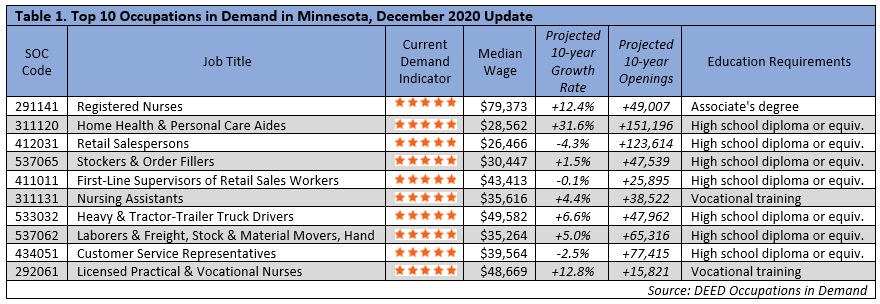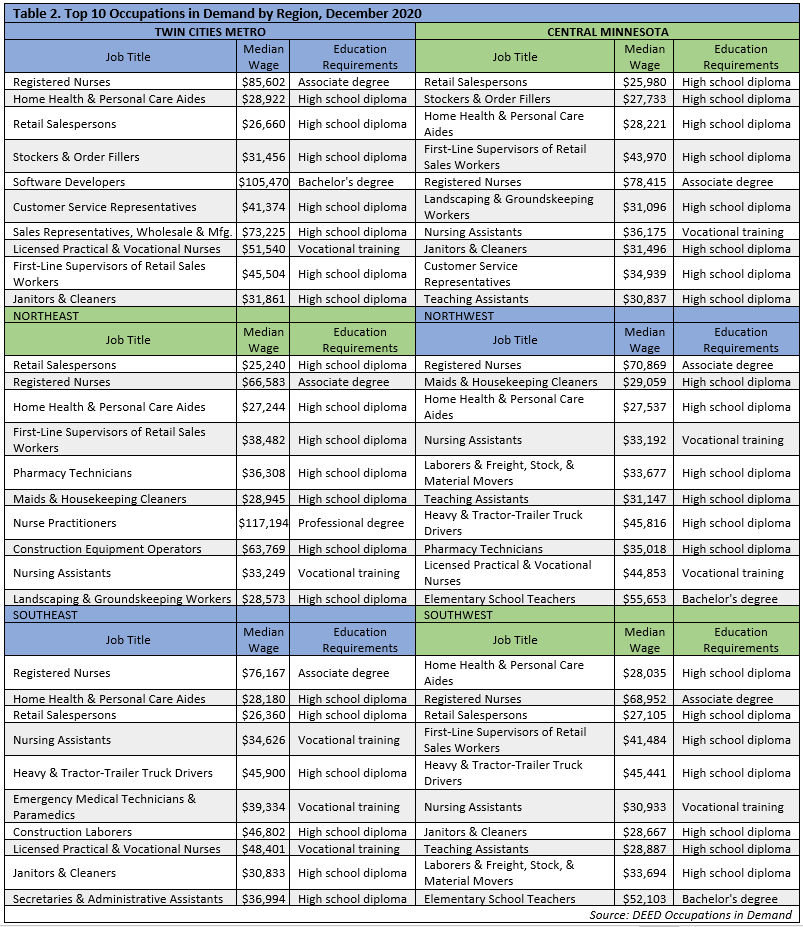
by Cameron Macht
December 2020
Having a comprehensive understanding of occupations in demand in Minnesota that considers current job vacancies, the number and types of jobs people have been laid off from, the prevalence of certain occupations in each region, longer term demand projections, and regional differences in labor market supply and demand is critical to helping employers, job seekers, career counselors and educators during these challenging times.
Even with economic uncertainty during the pandemic, thousands of Minnesota employers are looking for workers. Throughout the fall and even into the winter, there were an average of about 75,000 openings on any given day on MinnesotaWorks.net, the state’s online job bank, up considerably compared to the summer when postings hovered around 60,000 to 65,000 a day. But many employers with job openings are finding it difficult to locate and hire new workers.
This lack of applicants seems counter-intuitive since the number of unemployed workers surged nearly 250% in May 2020 compared to May 2019. It was more than 100% higher by September and was still up 33% in November 2020. A variety of factors are keeping some of these workers on the sidelines, including a mismatch between what skills employers are looking for and the skills of workers looking for jobs.
In the short-term, to help unemployed workers see at a glance what jobs are currently available, CareerForceMN started publishing a list of the top 30 jobs that are hiring now – which provided a summarized list of postings from Minnesota employers that are showing up on the National Labor Exchange, including openings from MinnesotaWorks.net and linking to additional information about each type of job as well as current job postings. As an immediate response to the labor market turmoil at the start of the pandemic, the first top 30 list was published in April, and has since been updated each month as new job posting data comes in. In addition, job seekers can always rely on the staff, tools, and resources available through CareerForce locations across the state to get back to work.
However, as we get a clearer picture of the impact of the pandemic, job seekers and employment counselors may be looking for more comprehensive and better information on how to transition back into the labor market that takes into account various factors related to labor market supply and demand. While the top 30 list was helpful as a tool for those looking for employment quickly, it included no analysis; it was simply a count of job postings. It did not take into account any other measure of labor market supply or demand.
For example, the list showed that there were currently more than a thousand jobs posted for cooks and food prep workers in the state, placing them in the top 30 for jobs that are hiring now. However, it did not address the fact that tens of thousands of people have been laid off from those same types of jobs. These displaced workers will likely be seeking re-employment in similar positions, creating increased competition that may be difficult to overcome. As a simple illustration, imagine 10,000 qualified job seekers vying for 1,000 jobs – 9,000 of those jobseekers are not going to be re-hired. With that kind of mismatch, unemployed workers hoping to get back into those jobs may need to rethink their path back into the labor force and consider a career change to one that is more in demand.
DEED’s Occupations in Demand (OID) tool was developed to provide a more comprehensive look at current demand for job seekers and career counselors, specifically in the Dislocated Worker program. The updated OID list is a ranking of occupations that have the most favorable demand conditions as measured by the following factors:
What jobs are open and available in the region now and have had openings since the start of the pandemic? (Source: Minnesota Job Vacancy Survey)
How large and prominent is each occupation in the region? (Source: Occupational Employment & Wage Statistics)
How many people were laid off and how hard has it been to find re-employment in an occupation since the start of the pandemic? (Source: Unemployment Insurance claims data)
First, a high number of current job vacancies will increase the occupation’s demand score. While overall vacancy numbers were down in 2020 compared to 2019, there is still widespread hiring opportunity in the state. The number of postings even increased over the year in some occupational groups, most notably health care support and health care practitioners. In contrast, there were huge declines for food preparation and serving positions, as well as personal care and service, production, sales and related, and office and administrative support occupations. At a high level, data show that demand for health care workers is up; while demand for leisure and hospitality workers is down.
Second, having a high number of people currently employed in the region according to the Occupational Employment & Wage Statistics (OEWS) program increases the demand score for that occupation. The more prominent an occupation is in the region, the more likely there will be continued demand for it. Large occupations like Retail Salespersons, Registered Nurses, and Customer Service Representatives exhibit constant hiring activity due to the sheer number of jobs available.
Third, the number of weeks of Unemployment Insurance (UI) benefits claimed by members of an occupation provides insight into layoff activity. Occupations with a high number of UI weekly claims mean there will be a surplus of available workers for those occupations, thereby reducing those occupations' demand scores because of expected difficulty with re-employment in a region. DEED’s new Profile of Risk for Prolonged Unemployment tool digs further into the demographics and occupations that are suffering the longest time on UI, helping steer job seekers away from jobs with higher layoff counts and slower labor market reattachment.
Another key component of the OID demand score is input from analysts in DEED’s Regional Analysis & Outreach Unit, which edit the lists based on local knowledge. For example, a regional analyst may have first-hand knowledge of a business opening soon, which will result in numerous job opportunities not yet captured by the Job Vacancy Survey, or focus on industries and occupations that have been targeted by local workforce development partners. These regional insights have been particularly important in this year’s update due to the uncertainty and volatility in the labor market, and the different economic circumstances experienced across the state.
Based on this comprehensive set of data, occupations are ranked and split into quintiles based on demand, with 5 stars representing the highest level of demand and 1 star the lowest. Statewide, there are over 100 occupations in the 5 star category and more than 325 occupations in the top three levels of demand. There are also over 200 occupations in low demand, including some that still have lots of job postings, though those are offset by even larger numbers of unemployed workers from those occupations.
In addition to displaying the OID scores, the OID tool also includes employment projections supplied by the Employment Outlook program, wage data from OES, information on the typical education (or degree) or training required, and details on related training programs offered around the state. This information helps the end user determine if the job is attractive to them and what additional skills or training might be necessary to obtain it.
Based on the Occupations in Demand December 2020 Update, four of the top 10 Occupations in Demand in Minnesota were health care careers – led by Registered Nurses in first place overall, followed by Home Health and Personal Care Aides, Certified Nursing Assistants, and Licensed Practical Nurses. Retail Trade and transportation and delivery have also been essential throughout the pandemic, leading to high demand for Retail Salespersons, Stockers and Order Fillers, Store Managers and other First-line Supervisors, and Customer Service Representatives, as well as Truck Drivers and Freight, Stock, and Material Movers (see Table 1).

While these occupations are in demand across the state, Minnesota’s economic landscape is as diverse as its geography. Every region has a different set of distinguishing industries which translate into different staffing requirements. Southeast has the highest concentration of Health Care employment in the state; while Northeast has most of the state’s Mining jobs. The Twin Cities has the most diversified economy overall, with strengths in Professional and Business Services; whereas Central, Northwest and Southwest all have larger shares of Manufacturing and Agriculture employment (see Table 2).

Efficient and successful labor markets require economic and workforce development partners that react quickly to changing supply and demand factors. Employers benefit from attracting and hiring from a large pool of qualified workers while job seekers and their counselors need access to reliable information about occupational demand, wages and trends to move careers in the right direction. In addition, local education institutions should also be working to help provide an appropriate supply of qualified workers to fill local business needs by adapting their program offerings to local occupational demand conditions.
OID is a critical reference for strengthening the partnership between workforce services, employers and training providers. In particular, Dislocated Worker program planners, career counselors and Workforce Development Boards are increasingly interested in using local labor market data to decide where best to allocate training resources.
In a challenging and uncertain economy, job seekers and career counselors can rely on DEED’s Occupations in Demand (OID) lists to gain a more comprehensive understanding of their local job market. While the regularly updated CareerForce listing of top 30 jobs being hired for now has its role as an introductory level career exploration and jobs search tool, the 2020 OID update aims to provide insight that can’t be gained simply by looking at job postings without also considering other labor market information.